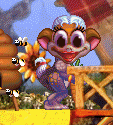Friday, August 19, 2011
Genetics Discussion: Purple Mountain Norns
"Down from the mountains of Albia, these purple Norns have developed differently. Indeed, these Norns even have some new genes."
The Purple Mountain Norn (PMN) was the first official breed to have a distinct genome from the original three breeds. (Although the original Santa Norn was infertile, he didn't have any novel genes to discuss.) Those changes were later carried over to the Life Kit breeds, the Forest and Ron Norns. Purple Mountain Norns were available as a download from Cyberlife's website, and some later copies of the game (like mine) came with them as part of the hatchery. The second Norn I ever hatched was a PMN named Aaron, by the way.
Below are excerpts from the output of a dDNA Analyzer comparison of a PMN genome (top) to a default Norn (bottom).
121 6 0 Emb B MutDup Lobe #= 7 State Rule: state PLUS type0 <end> <end> <end> <end> <end>, WTA= 1
121 6 0 Emb B MutDup Lobe #= 7 State Rule: state PLUS type0 PLUS type1 <end> <end> <end>, WTA= 1
This is a change to the seventh brain lobe, the attention lobe. Those commands are the State Variable Rules (SVRules) that affect how that lobe functions. As I understand it, the normal Norn's braid combines information from both type 0 and type 1 dendrites, while the PMN uses only type 0. Dendrites, connections between brain lobes, store information. In the attention lobe, type 0 dendrites connect to the stimulus source lobe, which identifies external stimuli (ex. "that is a Norn"), while type 1 dendrites connect to the noun lobe, which stores words the Creature has learned. By default, a PMN is therefore unable to make the connection between a word spoken by the hand and that it should look at the associated object. As described on the Creatures Developer Resource, this is a mistake made in very early copies of the game! Apparently, the executable itself was modified to work around this, which is why Sheena and Kratos don't have any trouble understanding when I want them to pay attention to the food I brought them, but the gene persists!
274 40 0 Emb B MutDupCut Creature, Sensorimotor, stagger, chem=Dancing, thresh=86, nom=0, gain=173, features=Analogue
274 40 0 Emb B MutDupCut Creature, Sensorimotor, stagger, chem=Alcohol, thresh=106, nom=0, gain=255, features=Analogue
This is an altered receptor gene that makes PMNs react to a new chemical -- chemical 80, "Dancing," also known as "Purple Mountain Alcohol." As you can see, it replaces the normal alcohol receptor. Like regular alcohol, it causes PMNs to "stagger" -- however, in these Norns, "stagger" has been replaced with, you guessed it, dancing. This also necessitated several changes in pose genes. The dancing concept was carried over into C2 through the Golden Desert Norns and Boney Grendels.
The following reaction genes are all novelties in the PMN.
308 51 0 Emb B Mut 1*Hunger-- + 1*Hunger => 1*<NONE> + 1*<NONE>; half-life = 32.
This gene, labeled "Hunger Reaction from Purple Mountain Norns" in the Genetics Kit, is present in addition to the regular hunger-reducing reaction, which goes 1 Hunger Decrease + 1 Hunger => 1 Reward. The two genes together mean that hunger decrease reduces the hunger drive more efficiently without triggering the release of any more reward than in a normal Norn. I suppose the same effect could have been achieved by altering the existing gene -- I can't really think of a good reason to have an entirely new gene.
321 60 0 Emb B MutDupCut 5*Geddonase + 5*Glucose => 5*Geddonase + 1*<NONE>; half-life = 72.
322 61 0 Emb B 2*Geddonase + 3*Glycogen => 1*Geddonase + 1*<NONE>; half-life = 88.
This is a very dangerous set of reactions, and the reason I've refrained from adding the cave fly cob to my world. Geddonase is a poison that has no effect on normal hatchery Norns; in PMNs, however, it reacts with both glucose (suger) and glycogen (long-term energy storage and the chemical behind a Norn's life bar). This makes geddonase quite dangerous, but luckily I believe there are no non-cob sources of geddonase in C1. Geddonase is also present in C2 -- it's injected by those irritating red gnats from one of the biodomes -- but, due to the more complex digestive system of C2 Norns, it's far less dangerous. Note also that the geddonase-glycogen reaction is set to be immuatable, un-duplicatable, and un-deletable.
323 62 0 Emb B 1*Dancing + 1*NFP => 3*Dancing + 1*<NONE>; half-life = 128.
324 63 0 Emb B 1*Dancing + 2*Boredom => 1*Boredom + 1*<NONE>; half-life = 112.
These two genes make dancing fun! It reacts to reduce need for please and boredom.
1 Half-lives 1 0 Emb B MutDup Dancing 48
1 Half-lives 1 0 Emb B MutDup Dancing 255
This is a change to the half-life gene. This gene describes the half-lives all the chemicals in the game will have in that particular Norn. A half-life is exactly what is sounds like: the time it takes for half of the amount of the chemical to decay. In real life, half-lives come up most frequently when radioactive materials are being discussed. That's how carbon dating and other radiometric time proxies work -- by measuring the relative amounts of different radioactive chemicals and working backwards to find out how much time it would take for them to decay that much. Impromptu science lesson! Anyway, in PMNs, this gene includes a half-life for the dancing chemical. Since chemical 80 was unused in the original Norns, it simply had the default value of 255 in them.
And that's it! Those are all the genetic changes made to the Purple Mountain Norns. The other two genetically modified official breeds, Forest and Ron Norns, have more complicated changes that maybe I'll address at a later time.
Labels:
creatures 1,
genetics
Subscribe to:
Post Comments (Atom)




No comments:
Post a Comment